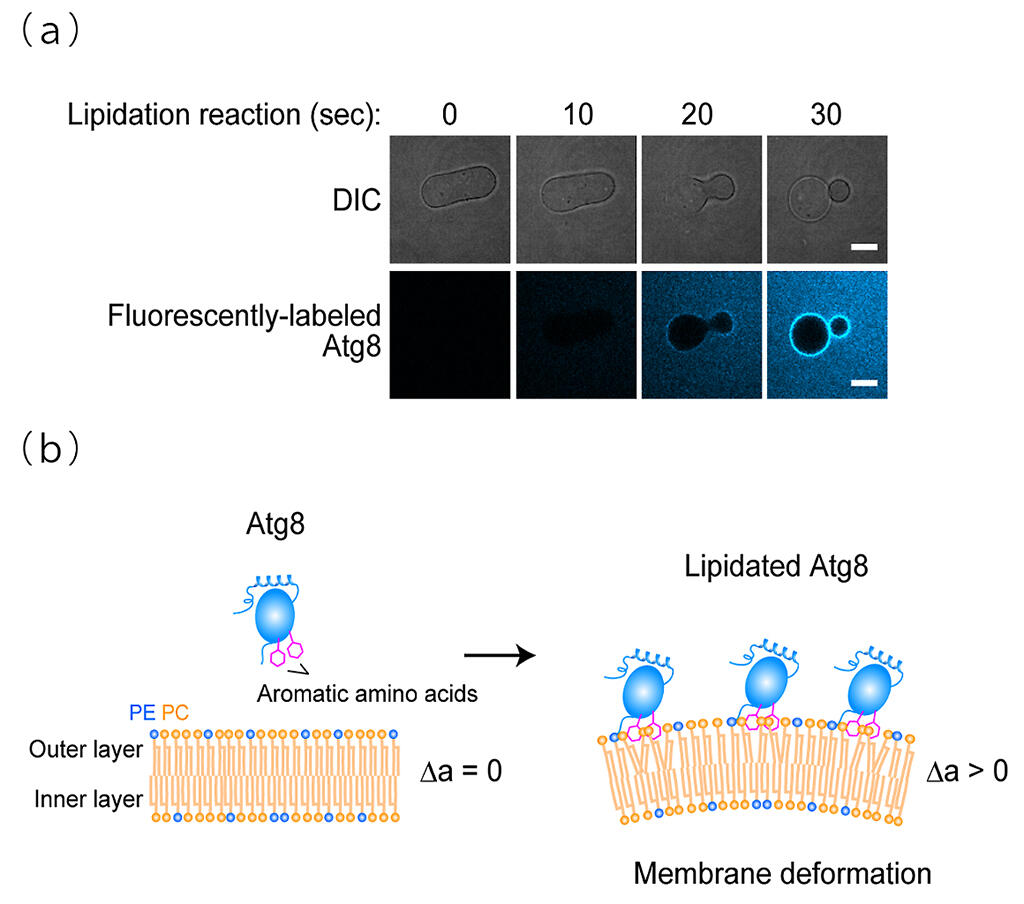The research group led by Dr. Nobuo N. Noda and Dr. Tatsuro Maruyama of the Institute of Microbial Chemistry, Microbial Chemistry Research Foundation has newly discovered that lipidized Atg8, a protein that plays a central role in autophagy, is an important mediator of changes in membrane morphology. It was clarified that Atg8 activity is important for the efficient formation of autophagosomes. This research result was obtained through a project supported by the JST Strategic Basic Research program.
In autophagy, a spherical lipid membrane structure called an autophagosome is created. The content to be decomposed is contained in this autophagosome and is then transported to the lysosome for decomposition. Although a general spherical artificial lipid membrane has been used for in vitro lipidation of Atg8, the isolation membrane, which is an autophagosome precursor, is non-spherical (that is, it exhibits a different shape). This has meant that it has been considered unsuitable for investigating the functionality of Atg8.
The research group prepared a giant elongated artificial lipid membrane morphologically similar to the isolation membrane. This membrane was used in the Atg8 lipidation reaction to investigate its effect on membrane morphology. As a result, the researchers found that with the formation of lipidated Atg8, the flattened lipid membrane was constricted and deformed into two spherical lipid membranes that were connected to each other. Through this it was shown that lipidated Atg8 can change the morphology of the membrane.
The change in the area of the lipid membrane during the lipidation reaction was measured using a micropipette and the membrane area increased with the formation of lipidated Atg8. They also analyzed the conformation of lipidated Atg8 on lipid membranes using a solution-NMR method.
The results of this revealed that lipidated Atg8 adopts a particular orientation with respect to the lipid membrane and that the aromatic amino acids of the lipidated Atg8 interact with the lipid membrane plane. Substitution of an aromatic amino acid to another amino acid led to the suppression of both the morphological change and the associated increase in the area of the membrane, indicating that lipidated Atg8 interacts with the lipid membrane via aromatic amino acids to exert its membrane-deforming activity. Furthermore, the researchers analyzed the importance of Atg8 aromatic amino acids using yeast and mammalian cells and found that mutation introduction into aromatic amino acids of Atg8 markedly reduced the efficiency of autophagosome formation in yeast cells. Similar mutations in mammalian Atg8 also resulted in reduced autophagy activity in mammalian cells.

(a) Upon lipidation reaction, prolate membranes are constricted at the hollow and transformed into a pear-like shape. DIC, differential interference contrast. Scale bars, 10 mm. (b) The area difference between outer and inner layers in the membrane, Da, is increased by the interaction of the aromatic amino acids in lipidated Atg8 with the outer layer, causing membrane deformation. PC, phosphatidylcholine. PE, phosphatidylethanolamine.
Credit: Institute of Microbial Chemistry (Journal article can be found at the following link: https://www.nature.com/articles/s41594-021-00614-5)
Dr. Noda said, "I think that the molecular activity of the major Atg proteins reported in 1993 by Professor Yoshinori Ohsumi of Tokyo Institute of Technology (2016 Nobel Prize in Physiology or Medicine) was roughly clarified by this result. In the future, we aim to understand the essence of the autophagy mechanism by reproducing the entire process in vitro using purified proteins and lipid membranes. We would like to develop a compound that specifically promotes and inhibits autophagy using the reconstruction system."
■ Lipidized Atg8: Atg8 that has formed a covalent bond with the phospholipids constituting the membrane. Phospholipids, a generic term for lipids with phosphate esters, have both hydrophilic and hydrophobic moieties and are mainly present in lipid membranes. As lipidated Atg8 is abundantly found in autophagosomes and sequestration membranes, it has been extensively used as an indicator molecule for studying autophagy.
This article has been translated by JST with permission from The Science News Ltd.(https://sci-news.co.jp/). Unauthorized reproduction of the article and photographs is prohibited.




